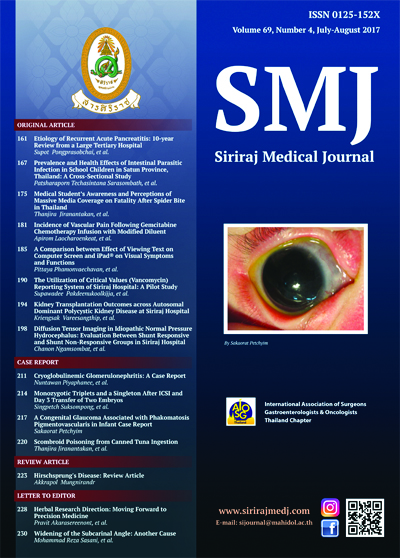Diffusion Tensor Imaging in Idiopathic Normal Pressure Hydrocephalus: Evaluation Between Shunt Responsive and Shunt Non-Responsive Groups in Siriraj Hospital
Keywords:
Normal pressure hydrocephalus, diffusion tensor imagingAbstract
Objective: Patient evaluation for the treatment of idiopathic normal pressure hydrocephalus (iNPH) with noninvasive investigation is helpful. Diffusion tensor imaging (DTI) can evaluate the microstructural change in brain parenchyma. The aim of this study was to compare diffusion tensor parameters in the brain before treatment in shunt responsive
and shunt non-responsive iNPH patient groups to identify any difference between groups.
Methods: Total 16 subjects with iNPH, 13 overall shunt responsive patients, and three overall shunt non-responsive patients were recruited and underwent MRI study (3-Tesla), including DTI with 32 gradient directions. Patients were scanned before cerebrospinal fluid tap test (CSF-TT) and shunt surgery. Fractional anisotropy (FA) and apparent
diffusion coefficient (ADC) between 2 groups were assessed by manual region of interest (ROI) method with FA color support. DTI parameters were correlated with the surgical outcome by clinical assessment.
Results: No statistically significant difference between overall outcome with FA and ADC in all ROIs was found. However, among the overall shunt responsive group, FA was higher, and ADC was lower than the overall shunt non-responsive group in almost all ROIs, except splenium of the corpus callosum (SPL). The difference was seen predominately at the body of the corpus callosum (CCbo) and genu of corpus callosum (GENU), but less at
corticospinal tract pathway (CST), including corona radiata, posterior limb of internal capsule, and corticospinal tract at pons level (CR, PLIC, and Po). Subgroup analysis also showed the same tendency in the gait shunt responsive group, urinary symptom shunt responsive group, and cognitive shunt responsive group.
Conclusion: DTI can investigate white matter microstructural change in the iNPH patient. The overall shunt responsive group tends to have higher FA and lower ADC than the overall shunt non-responsive group in almost all ROIs, except SPL. However, no statistically significant difference was found. Further study and comparison between pre and post shunt placement surgery in iNPH patients will be helpful.
Downloads
Published
How to Cite
Issue
Section
License
Authors who publish with this journal agree to the following conditions:
Copyright Transfer
In submitting a manuscript, the authors acknowledge that the work will become the copyrighted property of Siriraj Medical Journal upon publication.
License
Articles are licensed under a Creative Commons Attribution-NonCommercial-NoDerivatives 4.0 International License (CC BY-NC-ND 4.0). This license allows for the sharing of the work for non-commercial purposes with proper attribution to the authors and the journal. However, it does not permit modifications or the creation of derivative works.
Sharing and Access
Authors are encouraged to share their article on their personal or institutional websites and through other non-commercial platforms. Doing so can increase readership and citations.











